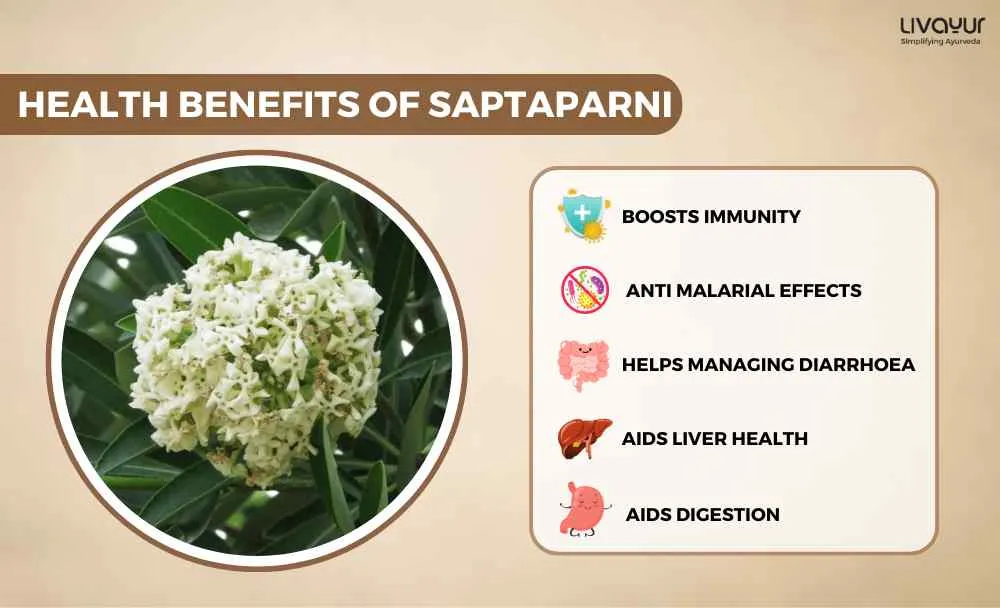
Saptaparni is an Ayurvedic medicinal herb with seven leaves that has been used traditionally in India for a long time. Science now shows it contains antioxidants and other compounds that may support good health and protect against disease. Although yet to be well known outside South Asia, Saptaparni is worth learning about for anyone interested in herbal remedies or plants with health-promoting properties.
The History of Saptaparni Plant
The Saptaparni plant has been used in India for a long time, especially in Ayurvedic medicine. Its other names are the “blackboard tree” and the “devil’s tree.” This plant has been important in Indian culture for centuries. The bark of the Saptaparni tree tastes very bitter, but it has been used in many traditional Indian remedies and medicines.
Nowadays, scientists are studying this tree more closely to understand all of its health benefits. Early research shows it might help fight infections, swelling, and even cancer! (1)
The Saptaparni tree still needs to be discovered in Western countries. However it has many promising health uses that are now being explored through modern science. Its long history in Ayurvedic treatments shows it is a valuable medicinal plant.
Facts About Saptaparni
- Saptaparni is a large deciduous tree native to India that can grow over 17–20 m tall.
- It is known as “Saptaparni” in Sanskrit, meaning “seven-leaved”. This refers to the pattern of leaves that typically grow in whorls of seven leaves each along the branches.
- The bark and leaves of the Saptaparni tree contain medicinal alkaloids and chemicals that make it a valuable herbal medicine.
- Saptaparni timber is lightweight yet durable. It has made Matchboxes, packing cases, ceiling planks, and light furniture.
- The tree has clusters of attractive white flower buds that bloom into lightly fragrant white flowers. These attract bees, butterflies and birds.
Health Benefits of Saptaparni
The multiple Saptaparni tree uses and benefits include:
1. Anti Malarial Effects
This plant’s leaf, bark, and root extracts have been tested for anti-malarial effects. The extracts contain anti-plasmodial compounds that fight against the malarial parasite Plasmodium falciparum. So, Saptaparni shows promise as a therapeutic against malaria. (3)
2. Healing Wounds
Application of Saptaparni leaves, either in paste form or as a decoction, helps to heal wounds, ulcers, and skin irritations quite effectively. (4) The antimicrobial and antioxidant properties promote faster skin tissue healing and regeneration.
3. Managing Diarrhea
Saptaparni has astringent properties, which help in managing diarrhoea and IBS symptoms. It helps to reduce inflammation and abnormal secretions of fluids, thereby solidifying stool consistency.
4. Boosting Immunity
With exceptional antioxidant capacity, Saptaparni helps to strengthen the immune system by fighting against free radical damage and oxidative stress. It helps boost immunity naturally so the body can fight infections, viruses, and diseases more efficiently.
5. For Liver
Saptaparni supports the optimal functioning of the liver. Its hepatoprotective activity safeguards the liver from damage. (6) It’s believed to stimulate regeneration and repair of liver tissue. The antioxidant content neutralises toxins, enhances bile secretion and promotes overall liver health.
6. Antimicrobial Effects
Compounds like flavonoids, tannins, and alkaloids found in Saptaparni exhibit antibacterial and antifungal activities against certain disease-causing organisms. This helps in treating various microbial infections. Research suggests Saptaparni can inhibit the growth of bacteria like Staphylococcus aureus. (5)
7. Treating Jaundice (2)
With excellent liver cleansing and protective actions, Saptaparni may help manage jaundice effectively. It improves the overall functioning of the liver, enhances bile flow, reduces bilirubin load, and repairs damaged liver tissue over time. This helps to treat the root causes of jaundice.
8. Other Health Benefits
Saptaparni offers a wide range of health benefits, including enhanced digestion, neuroprotective effects, managing cardiovascular diseases, antiulcer effects, anti-inflammatory properties, etc. With exceptional medicinal value, it has been used in various traditional medicinal practices.
Recommended Dosage of Saptaparni
Here are the key points regarding the recommended dosage of Saptaparni:
Bark Decoction
The recommended dosage is 20 – 80 ml daily, divided in doses based on the disease and patient condition.
Bark Powder
The recommended dosage is 1-1.5 grams per day. This can be taken in divided doses based on patient needs.
The appropriate dosage depends on the purpose of use and patient factors like age and health condition. Hence, consulting an Ayurvedic practitioner is advisable to determine a suitable dosage and regimen.
Side Effects of Saptaparni
Here are some potential side effects of Saptaparni (Alstonia scholaris) to be aware of:
- Saptaparni can sometimes cause digestive problems like nausea, vomiting, diarrhoea or constipation. It may irritate the gastrointestinal tract for some people.
- It has compounds that act as nervous system depressants. High doses can cause excessive sedation or drowsiness.
- In high amounts, Saptaparni can slow breathing rates significantly. This is dangerous for people with existing lung conditions.
- Saptaparni may lower blood pressure in some cases. This can cause lightheadedness or dizziness, especially when moving from lying to sitting or standing.
- Long-term use or high doses of saptaparni may potentially damage the liver. This is due to its alkaloid compounds.
- Kidney irritation is possible as the body tries to eliminate large amounts of the chemicals in saptaparni.
FAQs
1. What are the uses of Saptaparni?
The leaves, bark, and roots of the Saptaparni tree have medicinal uses in Ayurvedic treatments, including for joint pain, fever reduction, and wound healing. The tree is also used for timber, firewood, and fodder.
2. What are the side effects of Saptaparni?
When consumed in large doses, Saptaparni may cause nausea, vomiting, and diarrhea. It is generally considered safe in normal medicinal doses.
3. Why is Saptaparni called the devil’s tree?
Saptaparni is sometimes called the devil’s tree because it is believed to host evil spirits or demons, likely due to its unusual appearance during certain times of the day.
4. What is the common name of Saptaparni?
The common name for Saptaparni is the Seven-leaved Tree or Whipstick Albizia. It is scientifically known as Albizia lebbeck.
5. Is the Saptaparni tree good for home?
The Saptaparni tree is generally not recommended for planting inside home compounds or near homes as its large size and extensive root system can damage foundations and underground pipes and wires. It also sheds leaves, flowers, and pods that require cleaning.
Conclusion
Saptaparni is an Ayurvedic tree with immense medicinal value. Modern research is uncovering its antimicrobial, antioxidant, anti-inflammatory, anticancer, and immunomodulatory properties. This traditional Indian botanical remedy shows promise for treating diverse health conditions. More human studies are needed to validate its therapeutic efficacy and safety.
Disclaimer
The article aims to provide helpful information which should differ from professional medical advice. The content here is for informational purposes only. There are potential health risks with any medicinal herb, so consult your doctor before using Saptaparni or any supplement. Do your careful research as well. Let your qualified practitioner guide safe usage if you choose to try Saptaparni.
References:
- Early research shows it might help fight infections, swelling, and even cancer.(researchgate.net)
- Treating Jaundice (journalijar.com)
- Saptaparni shows promise as a therapeutic against malaria. (researchgate.net)
- Application of Saptaparni leaves, either in paste form or as a decoction, helps to heal wounds, ulcers, and skin irritations quite effectively. (researchgate.net)
- Research suggests Saptaparni can inhibit the growth of bacteria like Staphylococcus aureus. (researchgate.net)
- Its hepatoprotective activity safeguards the liver from damage. (ijbpas.com)














